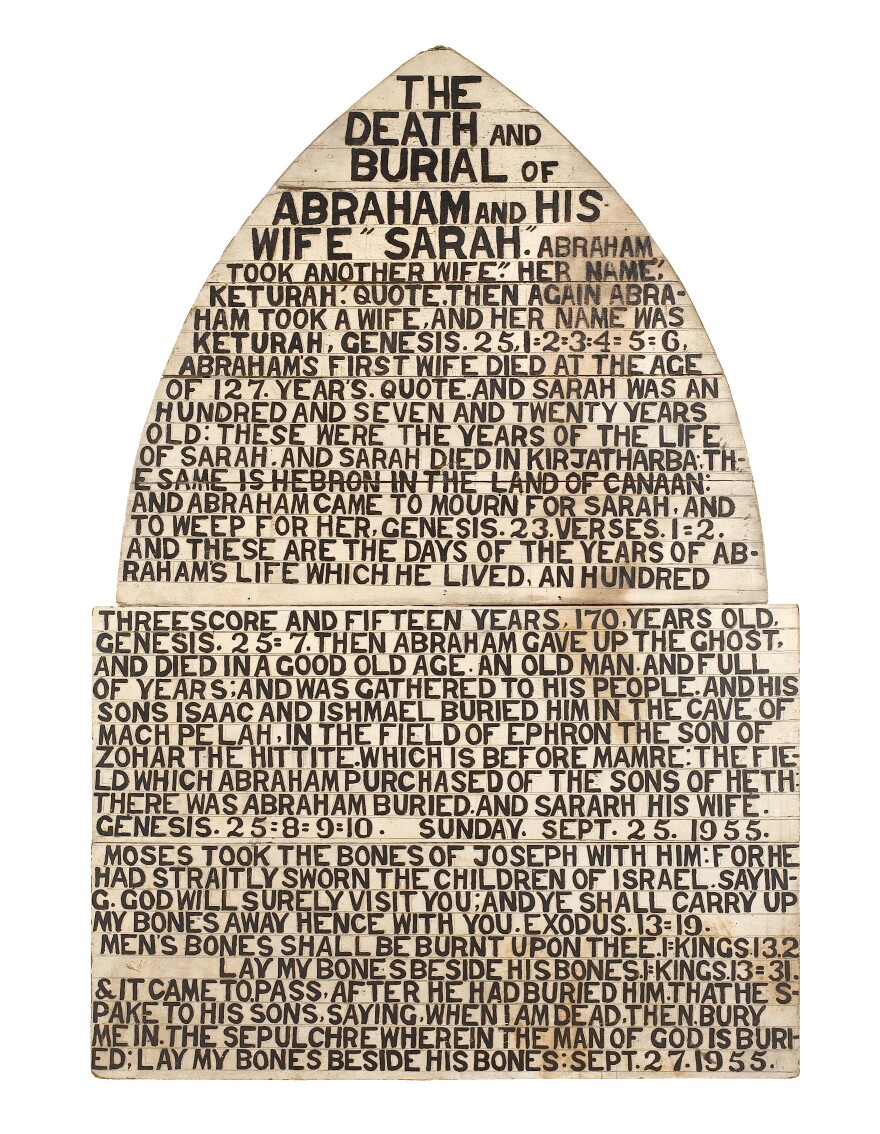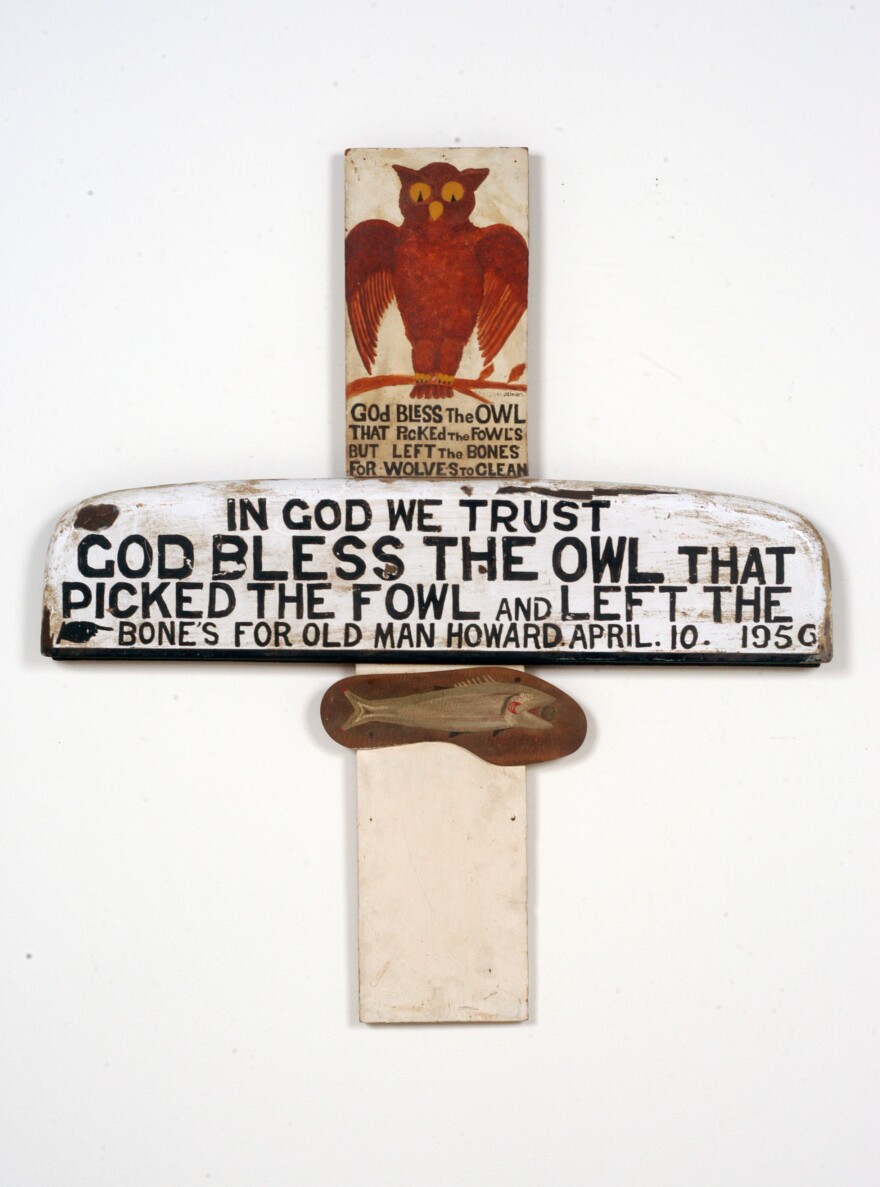By all accounts, self-taught artist Jesse Howard was cantankerous. In middle of the last century, it wasn't unusual to see hand-painted signs on country roads advertising a traveling fair or a farm sale. But Howard's signs offered Bible verses. They proclaimed his anger at his neighbors and the government, and his disappointments with the world around him. "Every word I'm saying's the truth," the artist said of his work. "Every word."
Howard's work hangs in the Smithsonian American Art Museum, the American Folk Art Museum in New York and the American Visionary Arts Museum in Baltimore. Now, the Contemporary Art Museum St. Louis has opened the first comprehensive survey of his work.

An Art Environment At Sorehead Hill
Howard's canvas was most often a wooden plank, some scrap metal salvaged from dilapidated outbuildings or any piece of farm equipment with a flat surface big enough to whitewash with house paint and cover with carefully-lettered, all-cap screeds.
The signs filled his 20-acre compound in the woodsy hills around the small town of Fulton, Mo. He called it "Sorehead Hill," but Smithsonian folk art curator Leslie Umberger calls it an "art environment," or a personal space that's "built or constructed by an individual who, for whatever reason, decides to kind of reshape his or her corner of the world."
Howard was one of three artists who started building these environments in the 1940s and '50s — Fred Smith in Wisconsin and Sam Rodia in California were the others. Before long, more well-known artists like Roger Brown and Jasper Johns started paying attention.

"It is completely different than what's happening in kind of the staid halls of mainstream art," Umberger says. "And it makes a big difference because people start to really equate this radicalism with having a strong voice, a strong opinion, being truly original, for standing up for what you believe in and fighting for it."
And Howard had to fight. According to Jeffrey Uslip, chief curator at the Contemporary Art Museum St. Louis, some of Howard's neighbors tore down his signs and vandalized his property. "In 1952, his neighbors applied to have him committed to an asylum," Uslip says. "And in, you know, '54 Jesse went to Washington to seek reparation. So it was a very fraught existence."
Howard got no help from Washington, but he managed to avoid the asylum.
Wall-To-Wall Jesse Howard
Having spent his early years as a migrant worker, Howard settled down to make his art while his wife took in ironing to scrape together a living. Then, in the late 1960s, the magazine Art in America ran a story about him. Artists started making pilgrimages to Fulton, and professors at the Kansas City Art Institute invited him to be a visiting artist. Raechell Smith, a curator at the institute, says, "I think it must have been a significant time for him in that he was surrounded by people who were recognizing him as an artist."

The institute now owns most of Howard's work, and loaned many of its pieces for the St. Louis show. Uslip also borrowed the Smithsonian's lone piece, as well as work from private collections, to recreate Howard's art environment. "What I wanted the exhibition to present is an authentic way in which Jesse lived and worked, which was floor-to-ceiling, wall-to-wall, fully enveloping the viewer in his first-person narrative," he says. "And I wanted to stay true to that."
Jesse Howard died in 1983, but there's a reason his new show is in a contemporary art museum: His art is still relevant, especially considering what's been happening in the streets of Ferguson, just outside St. Louis. "Life in St. Louis is a very charged time right now," Uslip says. "And I think Jesse's first-person narrative really speaks to a larger trajectory of how people are with each other, how people handle diversity and volatility, but really how this type of voice came to fruition."
Howard once said, "There's hundreds of people that can't speak what they want to speak. I do." Speaking what he wanted to speak didn't make life easy for Howard, but now at least people are listening.
Copyright 2021 KCUR 89.3. To see more, visit KCUR 89.3. 9(MDA3OTgyNDI4MDEzMTM0MjQzMTZlNDI0Mg004))


